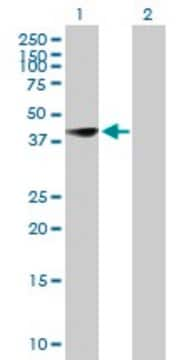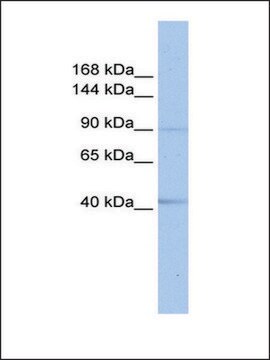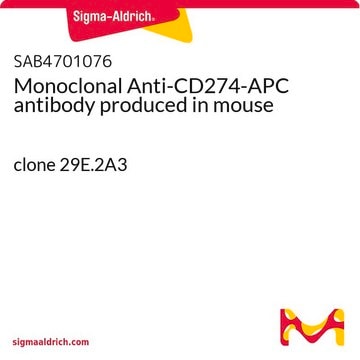일반 설명
We are committed to bringing you greener alternative products, which adhere to one or more of The 12 Principles of Green Chemistry.This antibody is Preservative-free, produced without the harm or sacrifice of animals and exceptionally stable to allow for ambient shipping and storage if needed and thus aligns with "Waste Prevention", "Designing Safer Chemicals" and "Design for Energy Efficiency".
Click here for more information.
ZooMAb® antibodies represent an entirely new generation of recombinant monoclonal antibodies.Each ZooMAb® antibody is manufactured using our proprietary recombinant expression system, purified to homogeneity, and precisely dispensed to produce robust and highly reproducible lot-to-lot consistency. Only top-performing clones are released for use by researchers. Each antibody is validated for high specificity and affinity across multiple applications, including its most commonly used application. ZooMAb® antibodies are reliably available and ready to ship when you need them.
특이성
Clone 1K19-H2 is a Rabbit recombinant monoclonal antibody that specifically detects Bad. It targets an epitope within 20 amino acids from the N-terminal region.
면역원
KLH-conjugated linear peptide corresponding to 20 amino acids from the N-terminal region of human Bad..
애플리케이션
Quality Control Testing
Evaluated by Western Blotting in HEK293 cell lysate.
Western Blotting Analysis: A 1:1,000 dilution of this antibody detected Bad in HEK293 cell lysate.
Tested applications
Western Blotting Analysis: A 1:1,000 dilution from a representative lot detected Bad in HepG2 cell lysate.
Immunocytochemistry Analysis: A 1:100 dilution from a representative lot detected Bad in NIH3T3 cell line.
Affinity Binding Assay: A representative lot of this antibody bound Bad with a KD of 8.1 x 10-8 in an affinity binding assay.
Immunohistochemistry (Paraffin) Analysis: A 1:100 dilution from a representative lot detected Bad in human kidney tissue sections.
Note: Actual optimal working dilutions must be determined by end user as specimens, and experimental conditions may vary with the end user
표적 설명
Bcl2-associated agonist of cell death (UniProt: Q92934; also known as BAD, Bcl-2-binding component 6, Bcl-2-like protein 8, Bcl2-L-8, Bcl-xL/Bcl-2-associated death promoter, Bcl2 antagonist of cell death) is encoded by the BAD (also known as BBC6, BCL2L8) gene (Gene ID: 572) in human. BAD is BH3-only pro-apoptotic member of the Bcl-2 family that lacks the C-terminal transmembrane domain for outer mitochondrial membrane and nuclear targeting. It is expressed in a wide variety of tissues. Following its activation, it forms heterodimers with anti-apoptotic members and prevents them from blocking apoptosis. It is reported to form heterodimers with Bcl-X(L), Bcl-2,and Bcl-W and promotes cell death. It is also reported to link survival signals to mitochondrial apoptotic machinery and its activity is regulated by survival growth signals. BAD can undergo phosphorylation on serine 75, 99, 118, and 134 in response to survival stimuli, which blocks its pro-apoptotic activity. Phosphorylation on serine 99 and 75 are also known to promote its heterodimerization with 14-3-3 proteins. Phosphorylated BAD is trapped by 14-3-3 and sequestered in the cytosol, however, once it is unphosphorylated, it translocates to the mitochondria to release cytochrome c. The interaction of BAD and 14-3-3 facilitates the phosphorylation at serine 118, a site localized within the BH3 motif (aa 110-124). This leads to the release of Bcl-X(L) and the promotion of cell survival. Serine 99 is shown to be the major site phosphorylated by Akt and serine 118 is mainly phosphorylated by protein kinase A. This ZooMAb® recombinant monoclonal antibody, generated by our propriety technology, offers significantly enhanced specificity, affinity, reproducibility, and stability over conventional monoclonals. (Ref.: Elmore, S. (2007). Toxicol. Pathol. 35(4); 495-516; Gajewski, TF., and Thompson, CB (1996). Cell. 87(4); 589-592).
물리적 형태
Purified recombinant rabbit monoclonal antibody IgG, lyophilized in PBS, 5% Trehalose, normal appearance a coarse or translucent resin. The PBS/trehalose components in the ZooMAb formulation can have the appearance of a semi-solid (bead like gel) after lyophilization. This is a normal phenomenon. Please follow the recommended reconstitution procedure in the data sheet to dissolve the semi-solid, bead-like, gel-appearing material. The resulting antibody solution is completely stable and functional as proven by full functional testing. Contains no biocide or preservatives, such as azide, or any animal by-products. Larger pack sizes provided as multiples of 25 μL.
재구성
300 μg/mL after reconstitution at 25 μL per vial. Please refer to guidance on suggested starting dilutions and/or titers per application and sample type.
저장 및 안정성
Recommend storage of lyophilized product at 2-8°C; Before reconstitution, micro-centrifuge vials briefly to spin down material to bottom of the vial; Reconstitute each vial by adding 25 μL of filtered lab grade water or PBS; Reconstituted antibodies can be stored at 2-8°C, or -20°C for long term storage. Avoid repeated freeze-thaws.
법적 정보
ZooMAb is a registered trademark of Merck KGaA, Darmstadt, Germany
면책조항
Unless otherwise stated in our catalog or other company documentation accompanying the product(s), our products are intended for research use only and are not to be used for any other purpose, which includes but is not limited to, unauthorized commercial uses, in vitro diagnostic uses, ex vivo or in vivo therapeutic uses or any type of consumption or application to humans or animals.








